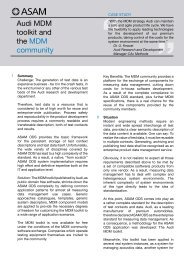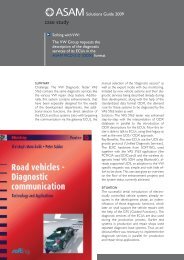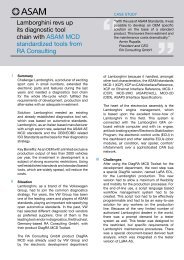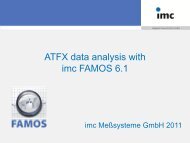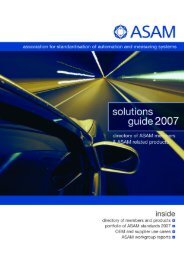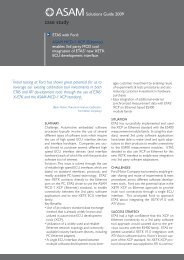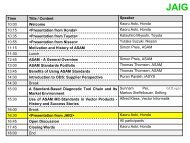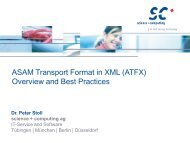Download now - ASAM
Download now - ASAM
Download now - ASAM
- TAGS
- download
- asam
- www.asam.net
Create successful ePaper yourself
Turn your PDF publications into a flip-book with our unique Google optimized e-Paper software.
A BASE STAnDARD defines syntax, abstract<br />
models, and principle functionality for general<br />
use A base standard is defined in a<br />
technology independent form It can use a<br />
problem specific notation, e g UML for an<br />
object model or any suitable description for<br />
protocols Typically a base standard is either<br />
a Format Description Standard, a Protocol<br />
Definition or an Application Programming<br />
Interface (API)<br />
An ASSOCIATED STAnDARD always refers<br />
to a Base Standard There are different forms<br />
of Associated Standards, such as Application<br />
Area Companions, Technology References,<br />
Transport Layer Specifications<br />
A fORMAT DESCRIPTIOn Standard defines<br />
the syntax and semantics of a file format used<br />
to exchange data Currently these standards<br />
are defined in XML, but older standards,<br />
such as <strong>ASAM</strong> MCD-2 MC (ASAP2) still apply<br />
proprietary ASCII formats<br />
There are also binary description standards,<br />
e g to store measurement data efficiently<br />
An APPLICATIOn AREA COMPAnIOn is an<br />
associated extension of the base standard<br />
for a particular type of devices or application<br />
areas A companion uses the syntax and<br />
the abstract models of the base standard In<br />
companion standards models for application<br />
fields are described (application specific information)<br />
Companion standards are technology<br />
independent<br />
A TEChnOLOGy REfEREnCE prescribes<br />
the technology dependent interpretation of<br />
the generic base standard These references<br />
are technology specific implementations of<br />
standards and companion standards appropriate<br />
for a specific environment<br />
06 section<br />
A TRAnSPORT LAyER SPECIfICATIOn details,<br />
how e g a generic protocol definition is<br />
to be interpreted using a concrete physical<br />
layer<br />
An <strong>ASAM</strong> InTERnAL STAnDARD (AIS) is a<br />
specification which does not directly serve as<br />
standard which can be implemented in tools<br />
but rather as a basis for the development of<br />
other <strong>ASAM</strong> standards<br />
AAS is a specification, and related extensions,<br />
which have been taken over from another<br />
organisation (e g MSR) and have been accepted<br />
by <strong>ASAM</strong> They are made available<br />
by <strong>ASAM</strong> but they are no official <strong>ASAM</strong> standards,<br />
because they are not maintained<br />
TyPES Of<br />
STAnDARDS<br />
113





